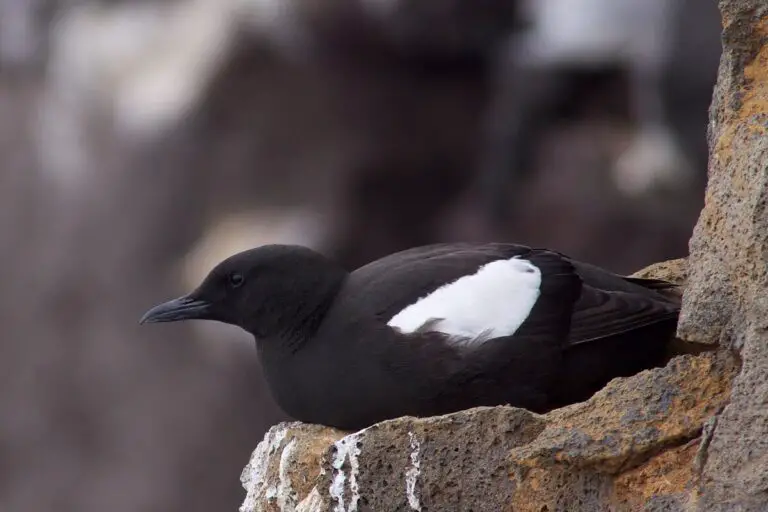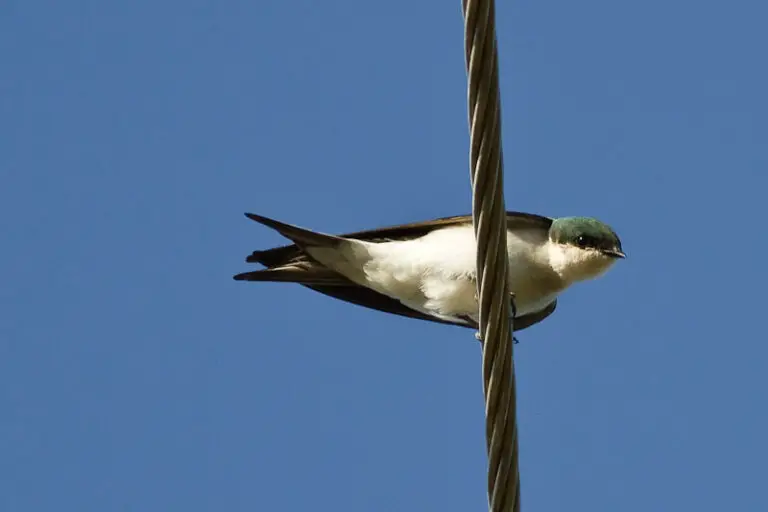Tufted Titmouse (B. bicolor)
“The tufted titmouse has a pretty simple song, but it is known to vary in at least 20 different ways.”
The Tufted Titmouse, scientifically known as Baeolophus bicolor, belongs to the following taxonomic classifications:
- Kingdom: Animalia
- Phylum: Chordata
- Class: Aves
- Order: Passeriformes
- Family: Paridae
- Genus: Baeolophus
- Species: B. bicolor
Its conservation status is categorized as “Least Concern,” indicating that it is not currently facing significant threats to its population. The Tufted Titmouse is commonly found in North America.
- Prey: Their diet mainly consists of insects, with caterpillars being a primary prey.
- Name of Young: The young ones are called nestlings.
- Group Behavior: Tufted Titmice are social birds.
- Estimated Population Size: Approximately 8 million.
- Wingspan: Their wingspan ranges from 7.9 to 10.2 inches.
- Incubation Period: Eggs are typically incubated for 12-14 days.
- Age of Independence: They become independent around 1 to 2 years of age.
- Age of Fledgling: Fledglings leave the nest at around 15-16 days old.
- Habitat: They inhabit mixed forests, gardens, and parks.
- Predators: Common predators include cats and birds of prey.
- Diet: Tufted Titmice are omnivores.
- Average Clutch Size: They typically lay around 6 eggs.
- Nesting Location: They nest in holes.
- Physical Characteristics:
- Color: They are predominantly grey with white markings.
- Skin Type: Covered in feathers.
- Lifespan: Their lifespan is around 2.1 years.
- Weight: They weigh between 0.6 to 0.9 ounces.
- Length: Their length ranges from 5.5 to 6.3 inches.
- Age of Sexual Maturity: They reach sexual maturity at around 1 year of age.
- Venomous: They are not venomous.
- Aggression: Their aggression level is generally low.
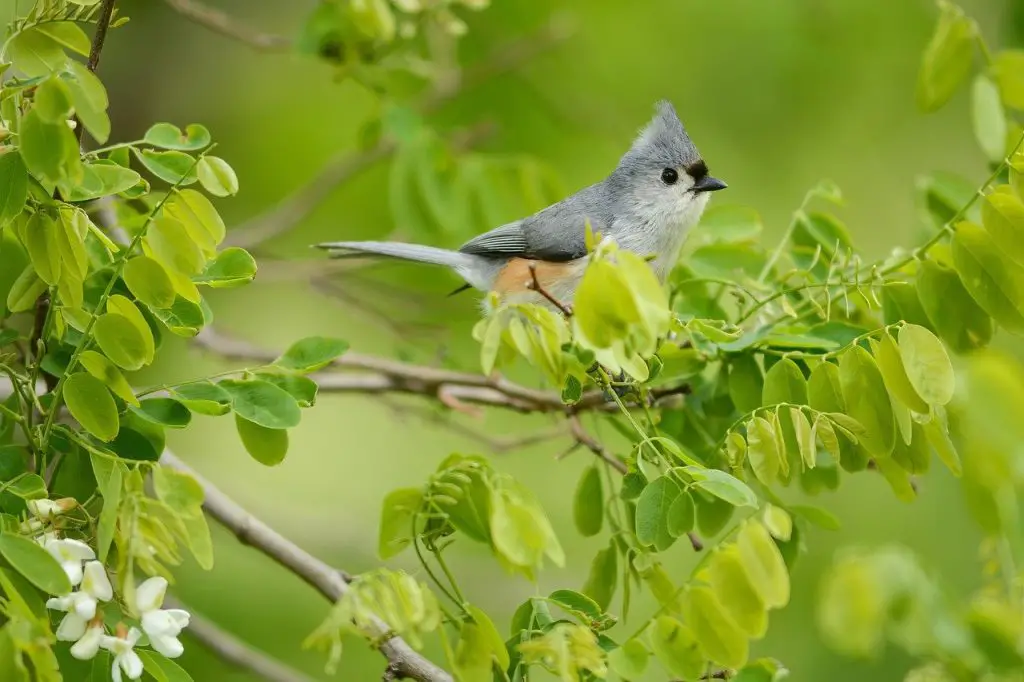
The Tufted Titmouse, a small songbird found in North America, belongs to the chickadee family and shares close kinship with other tit species. Recent DNA studies have uncovered genetic variations prompting the classification of this species into several distinct ones. This breakthrough in research enhances our understanding of bird diversity and evolutionary connections.
4 Amazing Tufted Titmouse Facts
- Song-lover: The Tufted Titmouse is quite the songster, known for its simple yet charming “peter-peter-peter” song. What’s intriguing is that this song can vary in over 20 different ways depending on the individual bird and the situation.
- Friend of Birdfeeders: Thanks to the presence of bird feeders, the Tufted Titmouse has expanded its range significantly. These feeders provide a reliable source of food, allowing the species to thrive beyond its original habitat throughout the year.
- Increasing Population: While many animal populations face decline, the Tufted Titmouse bucks the trend. Each year, its population is growing by approximately 1.5%, a testament to its adaptability and resilience.
- Curious Nature: With a keen sense of curiosity, the Tufted Titmouse isn’t shy about exploring its surroundings. It’s not uncommon for these birds to boldly peek into houses, displaying their inquisitive nature and adaptability to human environments.
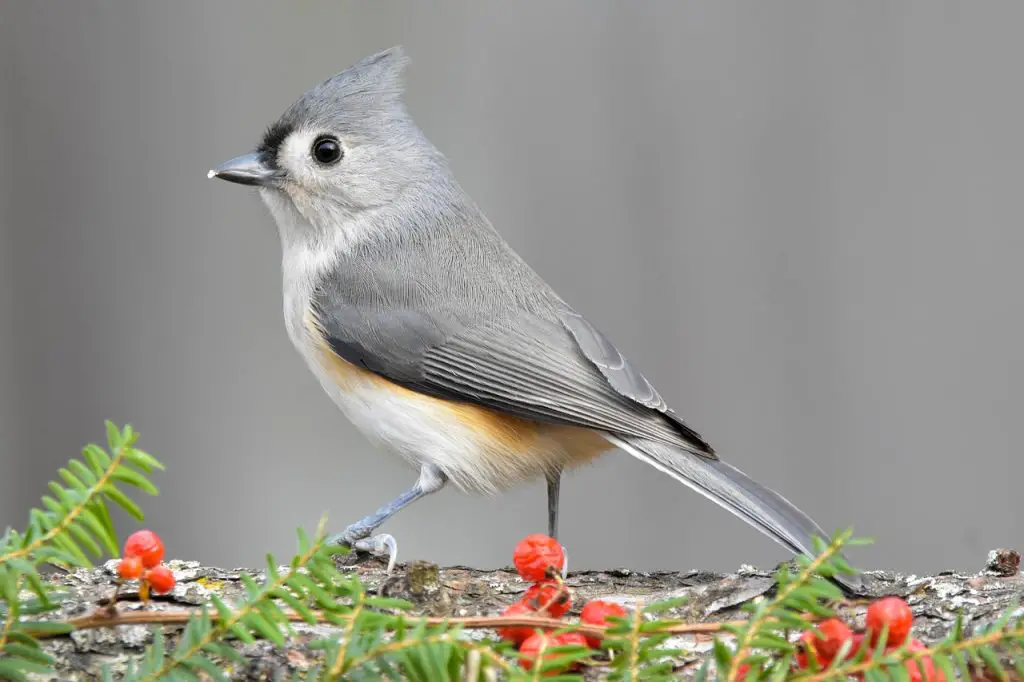
Where to Find the Tufted Titmouse
The Tufted Titmouse is a non-migratory bird, which means it stays put in its home territory all year round. Winter months offer prime opportunities to spot them, especially around birdfeeders when there’s less competition for food. However, regardless of the season, you can find them in regions where they’re native.
Originally, these birds were predominantly found in the Ohio and Mississippi River basins. Their non-migratory nature limited their spread farther north, as they needed to find food year-round in their local habitats. However, the advent of bird feeders has altered this pattern, enabling them to extend their range northward.
Nowadays, you can even encounter Tufted Titmice in places like Ontario and Quebec, where people reside. The presence of bird feeders plays a crucial role in their survival in these regions.
In terms of habitat, Tufted Titmice favor deciduous and mixed woodlands. However, they’re adaptable and can also be spotted in gardens and shrublands. They’re not too picky about the types of trees they inhabit, making them versatile residents of various environments.
Tufted Titmouse Nests
The Tufted Titmouse has a penchant for nesting in holes, often favoring naturally occurring ones in trees. However, they’re not picky and will readily occupy human-made nesting boxes or old woodpecker nests. Their attitude seems to be “any hole will do,” as long as it provides a cozy spot for nesting.
When it comes to nest-building, they follow a familiar routine observed in many bird species. Typically, they’ll line their nests with soft materials to provide comfort for their offspring. This can include animal hair, which they’ve been known to pluck from live animals like dogs. Additionally, nests have been discovered adorned with snakeskin, a surprisingly soft and insulating material that serves the same purpose.

Tufted Titmouse Scientific Name
The genus name Baeolophus, derived from the Greek words “baios” and “lophos,” meaning “small crested,” is aptly suited to the Tufted Titmouse, highlighting its distinctive crest. Its scientific name, Baeolophus bicolor, simply denotes its two-colored appearance. Therefore, when translated, the bird’s scientific name indeed signifies “small-crested, two-colored.”
Within the Baeolophus genus, there are five species, all sharing the common name “titmouse.” While they bear slight physical differences, these variations can be attributed to their slightly different ranges. Originally grouped under the genus Parus, recent classifications by the American Ornithological Society have re-categorized them.
The Tufted Titmouse, being a member of the Paridae family, is part of a group commonly referred to as “tits” or “chickadees,” depending on the region. This family encompasses a variety of small, perky birds known for their active nature and melodious songs.
Tufted Titmouse Size, Appearance, & Behavior
These birds are indeed quite petite, measuring only around 5.5 to 6.3 inches in length, weighing approximately 0.6 to 0.9 ounces, and boasting a wingspan of 7.9 to 10.2 inches. Compared to other avian species, they fall on the smaller end of the spectrum.
Sporting a distinctive appearance, Tufted Titmice have a white front and a grey body, often with rust-colored flanks and a black forehead. Their crowning feature is their tufted grey crest, from which they derive their common name. In younger birds, the black markings may be less prominent, occasionally leading to confusion with the oak titmouse.
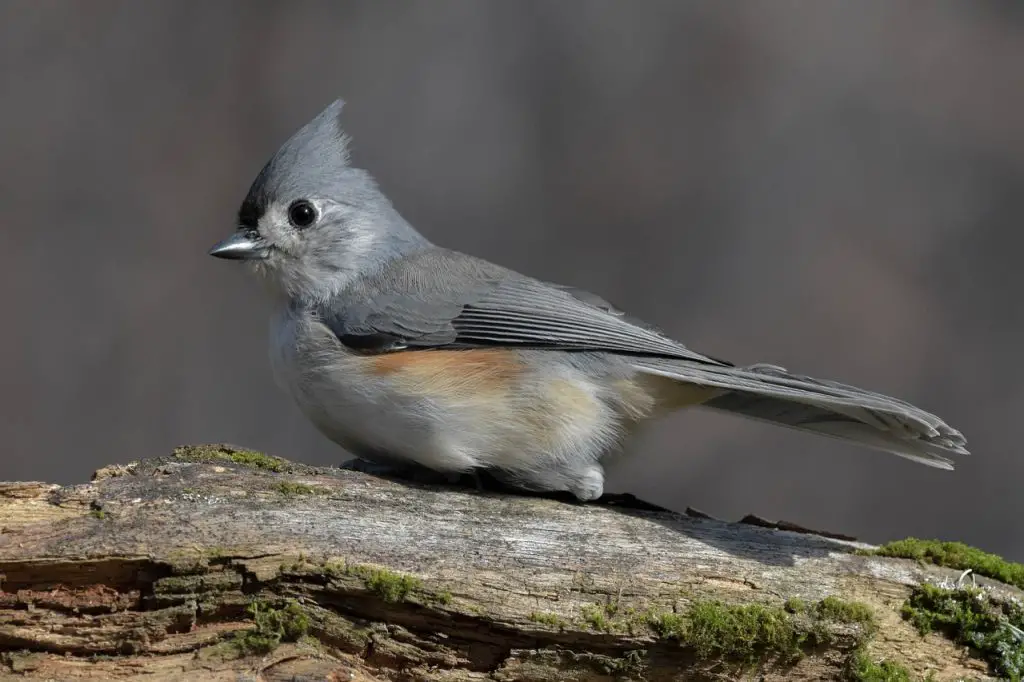
Renowned for their inquisitive nature, Tufted Titmice are known to exhibit considerable curiosity. It’s not uncommon to find them perched on windowsills, peering into houses, or trailing after people and other animals in yards. They’re also adept at clinging to windows and walls, scouring for insects.
These vocal birds display a keen understanding of the sounds of their avian counterparts. They readily respond to calls from other animals and often form flocks with their own kind. In the absence of fellow Tufted Titmice, they’ll join forces with similar bird species, demonstrating their sociable and adaptable nature.
Tufted Titmouse Diet
The Tufted Titmouse is quite the omnivore, feasting on a variety of berries, seeds, nuts, and other small plant materials. During the summer months, bugs and caterpillars also become staples in their diet.
These birds are regular visitors to bird feeders, especially in northern regions. In areas beyond their usual range, they heavily rely on bird feeders for sustenance, highlighting the importance of supplementary feeding for their survival.
When foraging, Tufted Titmice typically gather food from both the ground and branches. They employ a strategic approach, scouting out food sources from cover, swiftly flying in to grab a morsel, and then making a quick departure. Unlike some other bird species, they’re not inclined to linger on feeders for extended periods, preferring instead to grab their meal and go.
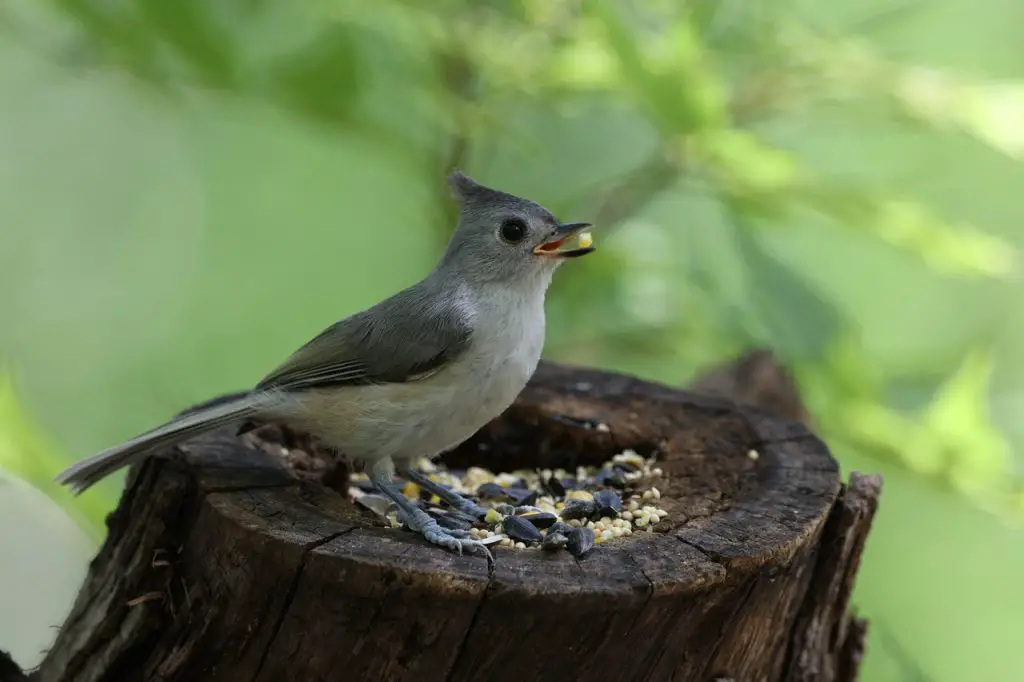
Tufted Titmouse Predators, Threats, and Conservation Status
Currently classified as “Least Concern,” the Tufted Titmouse is indeed thriving. Thanks to the widespread availability of birdfeeders, this species is expanding its range, and its population is steadily increasing by approximately 1.5% each year. Unlike many other animal species facing declines, the Tufted Titmouse is experiencing positive growth and is faring quite well.
Despite its success, the Tufted Titmouse does have its share of predators. Cats and birds of prey pose significant threats, with sharp-shinned and Cooper’s hawks being common predators within the titmouse’s typical range. However, virtually any bird of prey will target the Tufted Titmouse if given the opportunity.
Young Tufted Titmice are also vulnerable to predation. Snakes, raccoons, skunks, opossums, and squirrels are among the ground predators that may prey on nestlings or eggs. However, adult birds, equipped with flight capabilities, can typically evade these ground-based threats.
Reproduction, Young, and Molting
Once laid, the eggs of the Tufted Titmouse are remarkably tiny, measuring under one inch in size. Typically, they exhibit a white or off-white coloration with purplish spots. A typical clutch size ranges from five to seven eggs. These eggs require an incubation period of 12-14 days. After hatching, the young titmice spend an additional 15-16 days in the nest before they become fledglings, ready to venture out into the world.
In their natural habitat, Tufted Titmice have a relatively short lifespan, averaging about 2.1 years. However, in captivity, these birds can live for more than a decade.
Unlike many other bird species, Tufted Titmice exhibit a unique behavior where they remain with their parents throughout the first winter. In some cases, offspring may even stay with their parents for an extended period beyond that. Occasionally, a bird may assist in raising its siblings the following year before reaching breeding maturity at around two years old.
Although there are similarities between the Tufted Titmouse and the Black-crested Titmouse, breeding between these species is rare. This is mainly due to their distinct ranges, which do not significantly overlap, reducing the chances of interbreeding occurrences.
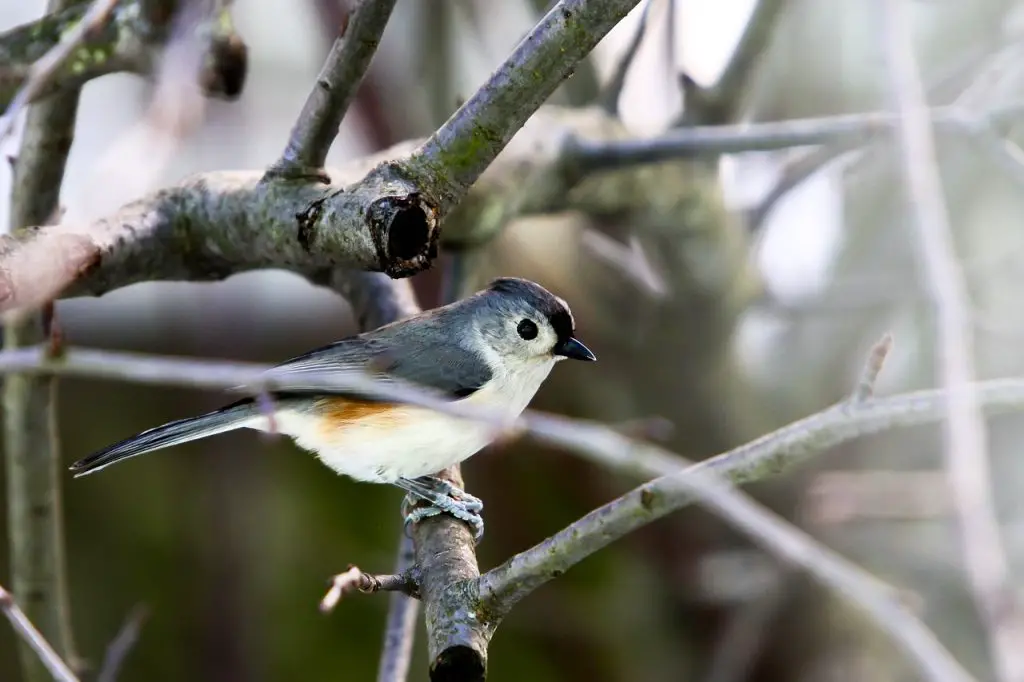
Population
The Tufted Titmouse boasts a sizable range and population, with approximately 8 million individuals currently estimated. With their population projected to increase by 1.5% annually, particularly as the species extends its range northward, they remain in the category of “Least Concern” in terms of conservation status. This positive outlook reflects the species’ adaptability and resilience, ensuring their continued presence and prosperity in the wild.
Before You Go…
The Tufted Titmouse is a resilient and adaptable songbird native to North America. With its charming appearance, inquisitive nature, and melodious song, it has captured the hearts of birdwatchers and enthusiasts alike. Thriving in a variety of habitats and benefiting from supplementary feeding, this species continues to expand its range and population, earning it a status of “Least Concern” in terms of conservation. As a symbol of resilience and adaptability, the Tufted Titmouse serves as a testament to the enduring beauty and vitality of nature’s avian wonders.




